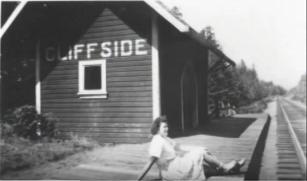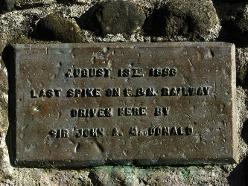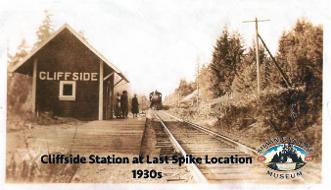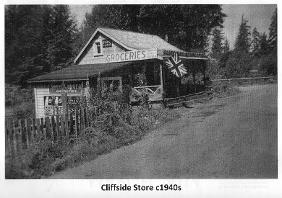



The Last Spike 1886 Shawnigan Lake at Cliffside
In 1883, the British Columbia Government appealed to Robert Dunsmuir to build a railway between Esquimalt and Nanaimo. In return, Dunsmuir received a substantial amount of money and a land grant that amounted to 20% of the land on Vancouver Island. The project took 3 ½ years. The 72 miles of track, which was laid starting from both ends, met at Mile 25 (Cliffside, Shawnigan Lake). In 1886, the inaugural train left Esquimalt with Robert Dunsmuir, Sir John A. MacDonald, their wives and other dignitaries. At Cliffside, Sir John ceremoniously placed the last spike. He used a silver hammer and pounded a gold spike.
A cairn was built at the site to commemorate the event. In 1986, the 100th anniversary of the E & N was celebrated with a second plaque. The original cairn and two plaques can be seen after a short hike north along the rails from Cliffside Road. Read More on the E&N by Lori Treloar.
Download a map of how to get to the Last Spike Site at Cliffside.
The Esquimalt & Nanaimo Railway
Black iron beasts belching steam, and billowing smoke, barreling through the fertile forests and verdant valleys of Vancouver Island. That, in essence, is what the Prime Minister of Canada promised the people of Vancouver Island. In 1873, Sir John A. Macdonald stated that Esquimalt, site of a busy naval base, should be the terminus for the Pacific Railway on Vancouver Island. Unfortunately, both the Federal government and the CPR considered it a low priority. In 1883, the British Columbia Government (desperate to avoid potential American control of the Islands railways, land and mineral rights) appealed to Robert Dunsmuir to build the railroad. Although a successful businessman, as well as a member of the legislature at the time, Dunsmuir had no interest in building the railroad and submitted a proposal that he thought would be rejected. It wasn’t. Was Dunsmuir the manipulator - or the manipulated? Either way, he stood to profit substantially from the railway contract.
In return for building the railroad Dunsmuir received $750,000 (federal money) and two million acres of Vancouver Island. This large land grant amounted to approximately 20% of the land on the entire island which included all of the known coal deposits. He also had the mandate to cut timber and build structures as he saw necessary. Dunsmuir had no qualms about expropriating land, as he saw fit, from the natives as he pushed the line through their land on the Victoria end. On September 27, 1883, The Esquimalt and Nanaimo Railway was incorporated. It took 3 ½ years to build, provided 72 miles of track, and was serviced by nine locomotives, between Esquimalt and Nanaimo. Much of the line was constructed by Chinese crews who worked in their own gangs and lived in their own camps. The railroad was a great benefit for the development of Vancouver Island as it gave access to the Islands forest and mineral resources which, in turn, provided jobs and encouraged settlement.
On August 13, 1886, Prime Minister Sir John A. Macdonald drove the last spike at Cliffside, on the east side of Shawnigan Lake at mile 25, with a silver hammer and a gold spike. This was the only visit the Prime Minister ever made to British Columbia. During this auspicious occasion Lady MacDonald and Mrs. Joan Dunsmuir, along with other distinguished guests, accompanied their husbands on the inaugural run in the Robert Dunsmuir’s luxurious railcar "Maude". According to one local historian, after driving the spike, Sir John and Robert were anxious to celebrate the event with a drink. Their wives were not in favour and they made it impossible for the men to "celebrate". However, once they reached Nanaimo, Robert Dunsmuir cannily suggested that the Prime Minister might like a closer inspection of one of Dunsmuir’s mine shafts. Although the ladies were also invited down the shaft, they heartily refused. The ladies had a long wait. Six hundred feet down in the mine shaft Robert was prepared. Finally, away from the women, the men had their celebration - with a case of Scotch Whiskey that Robert had stashed for the event.
In 1905, after the death of his father, James Dunsmuir sold the railroad and adjacent lands to the CPR for $2.3 million. The CPR owned and operated the line until 1999. It is estimated that the CPR, who gradually sold most of the E & N land holdings, made hundreds of millions of dollars in the bargain.
Needless to say, the advent of the railroad had a significant impact on the Cowichan Valley both economically and socially. The Cowichan Valley is well situated along the route - midway between the two major commercial centres of Victoria and Nanaimo.
Prior to the railway, the area relied on a weekly steamship to bring goods and ferry passengers. As a result of the railway, businesses began to develop and settlers arrived daily. Shawnigan Lake, which, hitherto, had been an uninhabited wilderness, flourished. Morton House, the first hotel at Shawnigan Lake was built in 1885 in anticipation of the railroad. This hotel was later renamed "Koenig’s Hotel and then "The Shawnigan Lake Hotel". A sawmill and lumber company was established at Shawnigan Lake in 1890 by a former E & N employee who could see the market potential in the forests around the lake. The Shawnigan Lake Lumber Company, which took over the company in 1892, provided many jobs, which, in turn, created the opportunity for social development in the area. Much of the lumber that was produced at the mill was transported by rail. By 1900, there were two large hotels at Shawnigan Lake serviced by the railroad.
On weekends several hundred people from Victoria came by train to the lake to dine and dance at the posh hotels. The first of many excursion trains destined for Shawnigan Lake arrived on Good Friday, April 8, 1887 with 200 passengers. These excursion trains brought people to Shawnigan for regattas, sculling matches, dances, picnics, band concerts and fishing parties. One such excursion brought 700 people to the lake.
Train was also the travel method for the many hunters and fisherman who sought the abundant fish and game around Shawnigan Lake. Since land was relatively inexpensive at the time many of these men bought large pieces of property around the lake and established hunting/fishing cabins. As the community grew, the train station became the centre of daily life for many of the settlers. Large groups of people would arrive, mostly by water, to wait for the morning mail train. This was the perfect opportunity for residents to discuss the news or catch up on local gossip. The volume was so great at Shawnigan that during the 1930s and 1940s four passenger trains daily were necessary to service the area. Eventually the station agent was moved from Cobble Hill to Shawnigan due to the larger demand at Shawnigan.
Train travel was such a regular part of daily life that even the pets knew the routine. One family who traveled from Victoria to Shawnigan every weekend would bring their dog Dan. Although pets were not allowed in the passenger car, Dan would hide between the seats every trip and the conductor would pretend not to notice. One weekend the family did not make the trip to Shawnigan, for some reason, and they were distraught when Dan went missing. A Shawnigan neighbour noticed that the dog had arrived at Shawnigan without the family. He fed the dog and made sure that Dan was on the Sunday train back to Victoria. The dog, as per his usual habit, had walked the two miles from his house and boarded the train in Victoria for his weekend at the lake. Needless to say, the family was relieved to see their very tired dog when he returned home Sunday night.
On June 1, 1903, the E & N initiated a commuter option, available during the summer months, for the people at Shawnigan Lake. The train stayed overnight at Shawnigan and took businessmen into Victoria in the morning. At the end of the day the train returned to the lake with the commuters. This service ended in 1908. With the recent acquisition of the E & N from the CPR we may, once again, have the benefit of a service for the daily commuter - almost one hundred years later!
The E & N railroad provided Cobble Hill with the promise of a bright future. Originally, Cobble Hill was chosen to be one of the few station stops along the route. A large station, complete with station agent, was built. Across the street, a large hotel, the "Station Hotel (built in 1892) attracted the well-to-do from Victoria who were looking to get away to the country. In addition to overnight accommodation, the hotel offered a large entrance hall with a player piano, an elegant tea room, a lady and escort parlor and a beer parlor. People who came to buy land in the area often stayed at this hotel. Although the population was small, the town of Cobble Hill grew to a respectable size and daily life revolved around the comings and goings of the trains and the activity at the post office.
Several things accounted for the diminishing prosperity of Cobble Hill. The increase in travel by road decreased the passenger traffic by rail and then, adding insult to injury, the new highway completely bypassed Cobble Hill. Eventually, the station agent was transferred and the station itself was dismantled. The final blow for the community happened when the "Station Hotel burned to the ground in 1942, fifty years after it was built. Collectively these events hastened the end of the boon era for the small town of Cobble Hill.
Cowichan Station, another stop in the Cowichan Valley on the E& N line, also had great potential as a prosperous town. This station provided service for settlers, loggers and miners to the area. Established in 1885, Cowichan Station had a hotel, general store and a church among other businesses. For a while it seemed destined to rival the city of Duncan. Unfortunately, a fire in 1911 destroyed the entire town with the exception of the church. St. Andrew’s Church is still in use today, but the town never recovered.
Duncan, as we know it, was not slated to get a station. However, the community staged a large assembly of settlers and natives (approximately 2000 people) to welcome the train as Prime Minister Macdonald and Robert Dunsmuir made the official first run on August 13, 1886. Residents erected a beautiful arch of fir and cedar and children sang a welcome song. With such a warm reception the train made an impromptu stop. There were several appeals, from local residents, to Mr. Dunsmuir begging him to establish a station at Duncan. As the train pulled away from the crowd Dunsmuir made that promise. William Duncan agreed to subdivide his farm, the station was completed in 1887, and the townsite of Duncan sprung up around the new station.
The E & N railway has connected the communities of Vancouver Island for over one hundred years. These trains delivered merchandise, mail and passengers and took away the same. For the first half of the 20th century, the railway was an integral part of daily life - providing farmers with larger markets, transporting coal and lumber, and carrying thousands of workers and passengers to their destinations. However, the increase in family owned automobiles and improved roads took their toll on passenger travel by rail. Many times in recent years the E&N line narrowly escaped attempts by the CPR and subsequent owners to disband the passenger service. Fortunately, in each case, strong supporters rallied against the impending closure and kept the trains running.
If you have stories, pictures or information regarding people, property or incidents regarding life around Shawnigan Lake we would love to hear from you. We are compiling data regarding residents and property owners around the lake from the late 1800’s forward and every piece of information, and every story, even if it seems insignificant, adds to the overall picture of life at Shawnigan. We are also looking for people who are willing to be interviewed, or tell stories, on film about life at Shawnigan.
We look forward to your visits. Thanks for your support!
Lori Treloar - Executive Director
What to Find at the Museum
Contact The Museum
Provided by The Shawnigan Lake Historical Society
